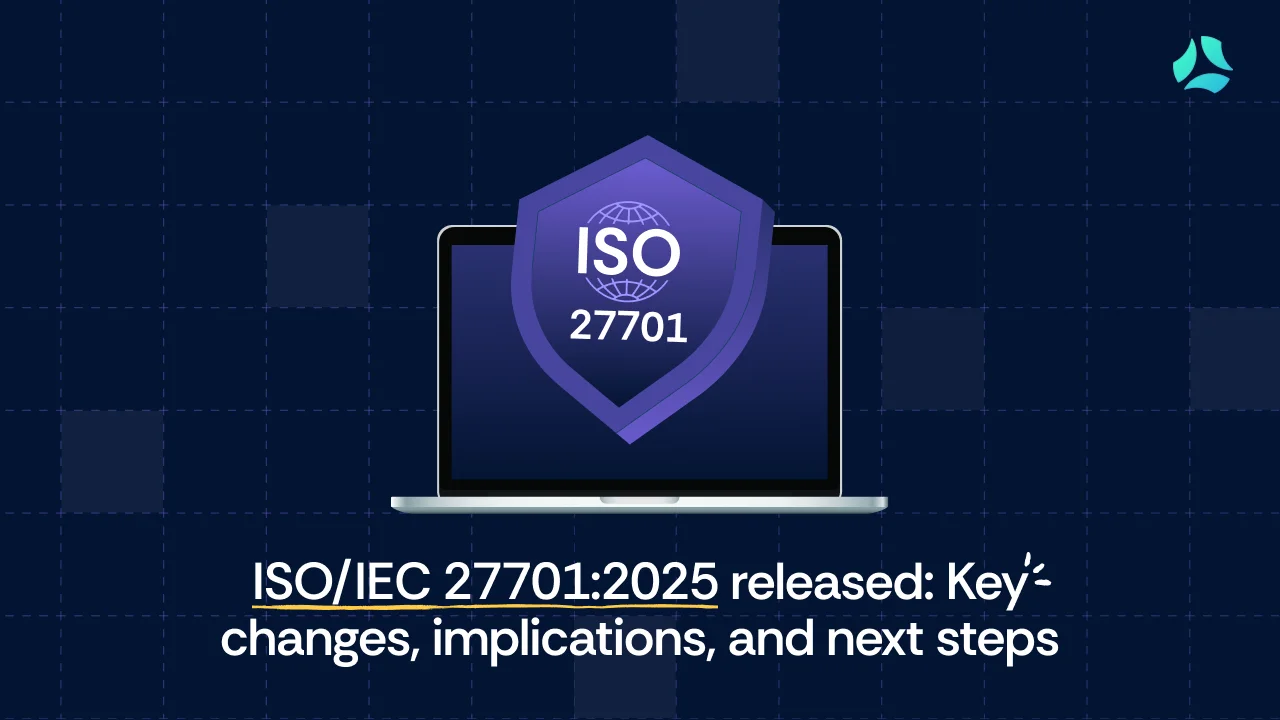Navigating financial services cybersecurity compliance

The financial services industry operates under some of the strictest regulations, designed to prevent fraud, protect consumers, and maintain market stability. However, staying compliant is no easy task.
A Thomson Reuters report found that over 60% of financial firms expect compliance costs to rise due to changing regulations and increased enforcement. But the cost of non-compliance is even higher—leading to hefty fines, reputational damage, and potential legal action.
To stay ahead, financial institutions need a strong compliance program that aligns with key regulations like AML (Anti-Money Laundering), GDPR, and Dodd-Frank.
In this blog, we’ll break down key financial regulations and their impact on the industry.
What is financial services compliance?
Financial services compliance refers to the process of ensuring that financial institutions—such as banks, investment firms, insurance companies, and payment processors—comply with legal, regulatory, and industry requirements. These regulations promote transparency, consumer protection, data security, and the prevention of financial crimes such as fraud, money laundering, and insider trading.
Key financial regulations vary by region. For instance, in the U.S., the Dodd-Frank Act strengthens financial stability, the Bank Secrecy Act (BSA) enforces anti-money laundering (AML) measures, the Gramm-Leach-Bliley Act (GLBA) governs financial data privacy, and Sarbanes-Oxley (SOX) regulates corporate financial reporting. In the EU, MiFID II enhances market transparency, while GDPR enforces strict data protection. Globally, Basel III sets banking risk standards, and the Financial Action Task Force (FATF) establishes AML and counter-terrorism financing (CTF) guidelines.
Why is financial services compliance important?
Financial compliance is crucial for maintaining the integrity of financial markets, protecting consumers, and preventing illegal activities.
Key benefits of financial services compliance:

- Risk mitigation: Reduces legal, financial, and reputational risks associated with non-compliance.
- Consumer trust: Ensures customer data privacy and fair financial practices.
- Regulatory compliance: Prevents penalties, fines, and potential license revocation.
- Operational efficiency: Streamlines reporting, audits, and financial controls.
- Fraud prevention: Protects against money laundering, insider trading, and fraudulent transactions.
How to choose the right financial services compliance?
Selecting the right financial service compliance solution depends on your business model, jurisdiction, and regulatory requirements.
Key features to look for:
- Regulatory coverage: Must align with relevant laws like GDPR, SOX, or MiFID II.
- Automated compliance monitoring: AI-driven monitoring for real-time regulatory updates.
- Data security and privacy: Encryption, access controls, and secure data storage.
- Audit and reporting tools: Centralized dashboards for regulatory reporting and documentation.
- Third-party risk management: Monitors compliance of vendors and partners.
- Scalability: Adapts to regulatory changes and business growth.
- Integration capabilities: Works with existing banking, payment, or financial systems.

Who oversees financial compliance?
In the U.S., several regulatory bodies oversee financial compliance to ensure market stability, consumer protection, and prevent financial crimes. These authorities include:
Primary financial regulators
- Federal Reserve: The U.S. central bank that regulates monetary policy, controls inflation, and ensures economic stability. It operates independently to prevent political influence.
- Securities and Exchange Commission (SEC): Regulates securities markets, enforces transparency, and monitors financial reporting to prevent fraud and market manipulation.
- Federal Deposit Insurance Corporation (FDIC): Insures bank deposits up to $250,000, examines banks for financial stability, and enforces consumer protection laws.
Additional key regulators
- Financial Industry Regulatory Authority (FINRA): A self-regulatory organization that oversees brokerage firms and securities markets to maintain fair trading practices.
- Financial Crimes Enforcement Network (FinCEN): FinCEN is a bureau of the U.S. Department of the Treasury that supports anti-money laundering (AML) and counter-terrorism financing (CTF) efforts. It collects and analyzes financial transaction data, such as Suspicious Activity Reports (SARs), and shares intelligence with law enforcement and regulatory agencies. While it does not directly enforce laws, it plays a central role in coordinating and enabling enforcement actions.
- Office of the Comptroller of the Currency (OCC): Regulates and supervises national banks and federal savings associations to ensure financial soundness and compliance.
Each of these organizations plays a crucial role in maintaining financial compliance, protecting investors, and upholding the integrity of the financial system.
What are different financial service compliance regulations, standards, and frameworks?
US regulations and frameworks
1. Gramm-Leach-Bliley Act (GLBA) (Law)
The Gramm-Leach-Bliley Act (GLBA) of 1999 mandates that financial institutions disclose how they protect consumer financial data and regulate data-sharing practices. It consists of:
- Financial privacy rule – Governs the collection and disclosure of personal financial information.
- Safeguards rule – Requires financial institutions to develop a written data security plan.
- Pretexting provisions – Prohibits obtaining personal financial data under false pretenses.
Non-compliance can result in significant fines and reputational damage.
2. Sarbanes-Oxley Act (SOX) (Law)
Enacted in 2002 after corporate accounting scandals such as Enron and WorldCom, SOX enhances corporate governance and financial transparency. It requires publicly traded companies to maintain strong internal controls over financial reporting, with executives personally liable for financial misstatements. Non-compliance can lead to criminal charges and severe financial penalties.
3. Payment Card Industry Data Security Standard (PCI DSS) (Standard)
Developed by the PCI Security Standards Council (PCI SSC), PCI DSS is a global security standard for organizations that handle credit card transactions. It mandates data encryption, secure authentication, and network security to prevent payment fraud and data breaches. Non-compliance can result in fines, penalties, and loss of payment processing privileges.
4. New York Department of Financial Services (NYDFS) Cybersecurity Regulation
The NYDFS Cybersecurity Regulation (23 NYCRR 500) is a U.S. financial compliance law requiring banks, insurers, lenders, and third-party vendors regulated by NYDFS to implement cybersecurity policies, risk assessments, and incident response plans.
It aligns with the NIST Cybersecurity Framework, mandates a Chief Information Security Officer (CISO), and requires regular cybersecurity testing, including penetration testing, vulnerability assessments, and annual compliance certification. Small businesses with fewer than 10 employees or under $5 million in revenue may qualify for exemptions or less than $10 million in year-end total assets.
EU and UK regulations, directives, and frameworks
1. General Data Protection Regulation (GDPR) (Regulation)
Implemented in 2018, GDPR is the EU’s primary data protection law, governing the collection, processing, and storage of personal data. It applies to any organization worldwide that processes personal data of EU/EEA residents, regardless of where the company is based. GDPR enforces strict requirements on user consent, data security, and breach notification. Non-compliance can lead to fines of up to €20 million or 4% of global annual turnover, whichever is higher.
2. Payment Services Directive 2 (PSD2)
The Payment Services Directive 2 (PSD2) is an EU regulation enhancing security, transparency, and competition in digital payments across the EU and EEA. It mandates strong customer authentication (SCA) for online transactions and requires banks to share consumer account data with third-party providers (TPPs) upon consent, fostering open banking. By enforcing secure APIs for data sharing, PSD2 bridges the gap between banks, fintech firms, and payment service providers, promoting innovation while ensuring consumer protection and fraud prevention.
3. Digital Operational Resilience Act (DORA)
The Digital Operational Resilience Act (DORA) (Regulation (EU) 2022/2554) enhances cyber resilience for banks, insurers, investment firms, and ICT vendors in the EU financial sector. Effective January 17, 2025, it enforces ICT risk management, incident reporting, resilience testing, threat intelligence sharing, and third-party risk management. Non-compliance can result in fines of up to 2% of global turnover, €1 million for individuals, and €5 million for critical ICT providers, along with service suspensions and corrective actions.
4. UK Senior Managers and Certification Regime (SMCR) (Framework)
A UK-specific compliance framework that assigns personal accountability to senior managers in banks and investment firms. It is designed to prevent misconduct and enhance governance. SMCR also enforces fitness and propriety assessments to ensure key personnel meet regulatory standards.
5. UK Financial Conduct Authority (FCA) Regulations
It regulates banks, insurers, financial advisers, and investment firms to ensure fair treatment of consumers, market integrity, and consumer protection. The FCA also enforces anti-money laundering (AML) rules, market integrity standards, and consumer protection measures.
Global standards and frameworks
1. Basel III (Framework and standard)
Developed by the Basel Committee on Banking Supervision (BCBS), Basel III is a global regulatory framework that strengthens banking sector resilience. It sets:
- Minimum capital adequacy requirements.
- Stress testing and liquidity risk measures.
- Leverage ratios to prevent excessive risk-taking.
While not legally binding, Basel III is adopted into national banking regulations worldwide. Non-compliance can lead to capital penalties, operational restrictions, and heightened regulatory scrutiny.
2. ISO 27001 (Standard) and ISO 27701 (Privacy Extension) (Standard)
While not finance-specific, these data security and privacy standards are widely adopted in financial institutions. ISO 27001 establishes requirements for information security management systems (ISMS), while ISO 27701 extends it to privacy information management (PIMS), helping organizations comply with global data protection regulations like GDPR.
These regulations, directives, and frameworks shape financial compliance worldwide, requiring institutions to maintain robust policies and procedures to meet legal and regulatory expectations.
Automating compliance management in financial services with Scrut
Automating compliance management is crucial for financial institutions to reduce risk, improve efficiency, and stay ahead of evolving regulations. Manual processes are slow, error-prone, and costly.
Scrut automates evidence collection, real-time monitoring, and AI-driven risk analysis to ensure financial compliance. Its centralized dashboard streamlines audits and reporting, while pre-built controls and proactive risk management help institutions stay compliant, avoid penalties, and focus on growth.

Frequently Asked Questions
What are the fundamental compliance requirements for financial institutions?
Financial institutions must adhere to several key obligations:
- Licensing and registration: Obtain necessary licenses to operate legally.
- Risk management: Implement systems to identify and mitigate risks.
- Reporting obligations: Submit financial reports and suspicious activity reports to regulators.
- Consumer protection: Ensure fair treatment, transparent disclosures, and effective dispute resolution.
What are the challenges of financial services compliance?
Financial institutions face various compliance challenges:
- Evolving regulations: Frequent changes require continuous monitoring.
- Technological advancements: Addressing cybersecurity threats and digital currency risks.
- Resource allocation: Balancing compliance costs with operational efficiency.
- Globalization: Navigating complex regulations across multiple jurisdictions.
What are the best practices for ensuring compliance in financial services?
To manage compliance effectively, financial institutions should:
- Develop a compliance culture: Encourage ethical behavior at all levels.
- Continuous training: Keep staff updated on regulatory changes.
- Implement robust systems: Use technology to monitor transactions and ensure compliance.
- Regular audits: Conduct audits to assess compliance effectiveness.
- Engage with regulators: Maintain open communication to stay informed on regulatory expectations.


















